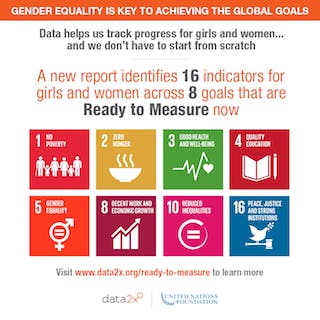
Complete this sentence: “If we want women and men to have equal opportunities, we need to _______.”
Ensure equal access to education?
Guarantee equal access to economic resources?
End violence against women in all its forms?
There is one response that probably did not come to mind: Promote collection and use of gender data. But don’t dismiss it. Gender data will have a real and powerful impact on achieving all of the above.
Realizing the ambitious promises made by the 17 Sustainable Development Goals – including but not limited to Goal 5 on gender equality – will require sweeping solutions. Central to the global goals is the charge to “leave no one behind.” Addressing the needs and rights of all women and men is critical to fulfilling this mission.
To achieve progress for women and men, individually and in relation to each other, we will need statistics that describe the unique circumstances of the population, broken down by sex. We will need to increase data collection in areas that disproportionately impact women or girls. And we will need to improve data collection methods that currently obscure their daily realities.
Last week, the United Nations Statistical Commission approved 230 draft indicators that will be used by the international community to measure progress toward achieving the global goals. These indicators will be the yardstick to measure success and will require national statistics systems and international agencies to produce and analyze an unprecedented amount of data.
With such huge demands for data, it may seem unreasonable to call for “more and better”’ gender data. But governments and international organizations recognize that to ensure women and men have equal opportunities, we need to fully understand their unique realities.
Data2X has worked to increase, improve, and promote gender data since its inception in 2012. We have identified gender data gaps across all areas of development, and built partnerships to close those gaps. Throughout our work, we have sought to challenge the assumption that collecting gender data is an insurmountable task, an approach which we carried over to our analysis of the indicators for the Sustainable Development Goals.
In partnership with the expert team at Open Data Watch, we found that we do not have to start from scratch to measure gender data for the global goals. We identified 16* indicators, across eight of the goals, that are “Ready to Measure.” These 16 indicators already have internationally-agreed upon definitions and data collection instruments. Examples include the prevalence of stunting (low height-for-age) in female children under 5 years of age, and ratio of female to male under-five stunting (an indicator for Goal 2: Zero Hunger); and the share of young women (15-24) who are not in school nor looking for work (“idle”), and female to male ratio (an indicator for Goal 8: Promote Economic Growth).
This is a big deal. Measuring progress on the 230 indicators of the Sustainable Development Goals is undoubtedly a big task, and doing so with a gender lens may seem all the more so. Our hope is that the “Ready to Measure” indicators can help us focus and kick-start the measurement of a gender baseline for the global goals.
The UN Statistical Commission closed last week, and the Commission on the Status of Women, a cross-section of UN, country, and civil society organizations that tirelessly work for the achievement of gender equality, is underway in New York. These commissions are inextricably linked; measurement is the connective tissue between ambition and practicality. We have a window of opportunity, early in the Sustainable Development Goals period, to focus on improved, usable, and integrated gender data. This integration is critical to achieving gender equality, and in turn, the historic sustainable development agenda.
*This paper was released before the indicator list for Sustainable Development Goals was approved. At that time, “Ready to Measure” identified 20 indicators, of which 16 are included in the approved indicator list.

